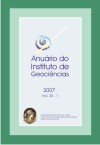Smooth layered microbial mats of the Brejo do Espinho, RJ, Brazil
DOI:
https://doi.org/10.11137/2007_1_181-187Abstract
Bogs are ecosystems found mainly in lower zones that separates inner and outer sandy terraces, and rivers and streams from valleys. These environments are always flooded or suffer seasonal flooding or can stay dry in a extended dry season. Its shallow waters increase the role of the sediment in the maintenance of such ecosystem. The Brejo do Espinho (22º56' S and 42º14'W) is a coastal body of water located 108 km from Rio de Janeiro city where are observed the development of thick microbial mats (about 2-4 cm in thickness). Aiming the characterization of the microbial mats, was made monthly collections in five collects in stations located in the bog borders. Microbial mats samples were taken using a spatula, deposited into plastics vials and later fixed with 4% formaldeid solution. For identification of the cyanobacterias, fresh and permanent slides were made. Smooth layered microbial mats present in subtidal and intertidal regions are composed by thin layers with different colors: green, red and brown, who show also distinct cyanobacterial composition. These structures show stratus of cohesive lamina with low lithification. Analysis revealed 27 species of cyanobacterias. Chroococcaceae Nägeli 1849 family was the main family found with 37% of the total frequency followed by Phormidiaceae Anagnostidis & Komárek 1988 family with 18,5%, Synechococcaceae Komárek & Anagnostidis 1995 family with 11,1%, Pseudanabaenaceae Anagnostidis & Komárek 1988 family with 11,1%, Entophysalidaceae Geitler 1925 family with 7,4%, Schizothricaceae Elenkin 1934 family with 7,4% and Oscillatoriaceae Gomont 1892 family with 7,4%. The domain of cyanobacterias in the Brejo do Espinho reflects its general plasticity that allows them to adapt to hostile conditions of the environment.Downloads
Download data is not yet available.
Downloads
Published
2007-01-01
How to Cite
Silva, L. H. da S. e (2007) “Smooth layered microbial mats of the Brejo do Espinho, RJ, Brazil”, Anuário do Instituto de Geociências. Rio de Janeiro, BR, 30(1), pp. 181–187. doi: 10.11137/2007_1_181-187.
Issue
Section
Article
License
This journal is licensed under a Creative Commons — Attribution 4.0 International — CC BY 4.0, which permits use, distribution and reproduction in any medium, provided the original work is properly cited.















